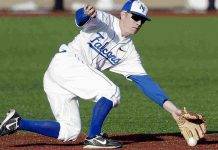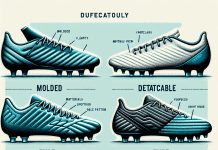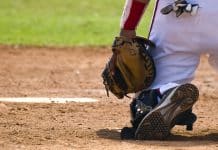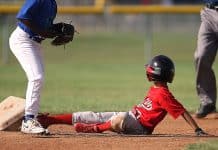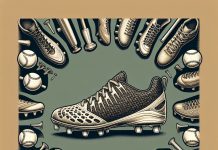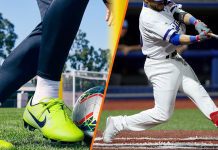Are you an avid baseball player? Do you find yourself wondering if investing in a pair of baseball cleats will have a significant impact on your performance? Look no further, because in this article, we will address the age-old question: Do baseball cleats make a difference? By exploring the benefits of wearing specialized footwear on the baseball field, you will gain insight into how these cleats can enhance your game and give you that competitive edge you’ve been searching for. Get ready to step up your game with the right pair of cleats!
Enhanced Performance
When it comes to enhancing your performance on the baseball field, having the right footwear can make a world of difference. Baseball cleats are specifically designed to improve various aspects of your game, giving you the edge you need to excel.
Review contents
Improvement in Traction
One of the key benefits of wearing baseball cleats is the improved traction they provide. The cleats on the sole of the shoe dig into the playing surface, whether it’s grass, turf, or dirt, allowing you to grip the ground better. This enhanced traction helps you maintain stability and prevents slipping, enabling you to make quick movements and explosive plays with confidence.
Better Stability
Stability is crucial in baseball, especially when you’re running the bases or making swift lateral movements. Baseball cleats are designed with stability in mind, featuring a supportive sole that helps distribute your weight evenly and prevent your feet from rolling. This added stability gives you better control over your movements, reducing the risk of injury and allowing you to perform at your best.
Increased Speed
Baseball is a game that requires speed, and baseball cleats can contribute to your speed on the field. The improved traction and stability provided by cleats allow you to generate more power with each step, propelling you forward faster. Whether you’re stealing a base or chasing down a fly ball in the outfield, the increased speed facilitated by your cleats can be the difference between making the play and falling short.
Improved Acceleration
In baseball, being able to accelerate quickly can give you a significant advantage. Baseball cleats help facilitate faster acceleration by providing you with the necessary traction and grip to push off forcefully from the ground. With every stride, the cleats dig into the surface, allowing you to generate maximum power and propel yourself forward. This improved acceleration can help you beat out throws, reach balls in the outfield, and steal bases more efficiently.
Enhanced Agility
Agility is a crucial skill in baseball, and having the right footwear can enhance your agility on the field. Baseball cleats are designed to be lightweight and flexible, allowing for quick and nimble movements. The supportive sole and improved traction of cleats enable you to change direction rapidly, pivot smoothly, and make sharp cuts with minimal effort. This enhanced agility can give you the upper hand when it comes to fielding ground balls, pursuing fly balls, or avoiding tags on the base paths.
Injury Prevention
While performance enhancement is a significant benefit of baseball cleats, they also play a vital role in injury prevention. By providing specific features and support, cleats help minimize the risk of common baseball-related injuries.
Reduced Risk of Slipping
Slipping and sliding on the field can lead to a variety of injuries, from twisted ankles to pulled muscles. Baseball cleats significantly reduce the risk of slipping by providing enhanced traction and grip. The cleats dig into the playing surface, allowing you to maintain stability and control even in slippery conditions. With reduced risk of slipping, you can focus on making plays without the fear of losing your footing and suffering an injury.
Ankle Support
Ankle injuries are common in baseball, as the sport involves a lot of lateral movements and sudden changes in direction. Baseball cleats offer excellent ankle support, thanks to their high-top design and supportive materials. The additional ankle support provided by cleats helps stabilize the ankle joint, reducing the risk of sprains and other ankle-related injuries. This support is particularly beneficial for players who have had previous ankle injuries or have weak ankles.
Protection from Injuries
Baseball can be a physically demanding sport, with balls flying at high speeds and players colliding on the field. Cleats provide an extra layer of protection for your feet and ankles in these situations. The sturdy construction and materials of baseball cleats help guard against impacts and provide a barrier between your feet and potential hazards. With the extra protection from cleats, you can play the game with confidence and minimize the risk of injuries.
Minimized Impact on Joints
Running and making quick movements on a hard playing surface can have a significant impact on your joints, particularly your knees and hips. Baseball cleats help minimize the impact by absorbing some of the shock with their cushioned soles. The cushioning reduces the stress on your joints, making running and movements more comfortable and reducing the risk of joint-related injuries. By wearing cleats, you can protect your joints and enjoy a more comfortable playing experience.
Optimal Comfort
Apart from performance enhancement and injury prevention, baseball cleats also prioritize comfort, ensuring you can focus on your game without any distractions.
Proper Fit
Having a proper fit is crucial when it comes to baseball cleats. Ill-fitting cleats can cause discomfort, blisters, and even contribute to injuries. Baseball cleats are designed to provide a snug and secure fit, ensuring proper foot placement within the shoe. Many models also offer adjustable features like laces and straps, allowing you to customize the fit to your liking. By wearing cleats that fit properly, you can enjoy optimal comfort and prevent potential foot problems.
Cushioning and Support
Baseball cleats are equipped with cushioning and support features to enhance comfort during prolonged periods of play. The insoles of cleats are often padded to provide additional cushioning and shock absorption, reducing discomfort and fatigue. The supportive midsole and arch support in cleats help distribute your weight more evenly, reducing strain on your feet and ankles. Overall, the cushioning and support features in baseball cleats contribute to a comfortable playing experience.
Reduced Discomfort
Playing baseball involves a lot of running, jumping, and quick movements, which can put stress on your feet and cause discomfort. Baseball cleats are designed to alleviate this discomfort by offering targeted support and cushioning. The cleats’ construction and materials are chosen to provide a balance between flexibility and stability, ensuring that your feet remain comfortable throughout the game. With reduced discomfort, you can focus on your performance and enjoy the game to the fullest.
Enhanced Breathability
Baseball cleats are designed to promote airflow and ventilation, keeping your feet cool and dry even during intense play. The materials used in the construction of cleats often include breathable mesh or perforations, allowing for proper ventilation and moisture wicking. This breathability prevents your feet from becoming hot and sweaty, reducing the risk of blisters and unpleasant odors. By keeping your feet cool and dry, cleats contribute to your overall comfort on the field.
Specific Cleat Types
Different types of cleats are available in baseball, each catering to specific playing conditions and player preferences. Understanding the differences between these cleat types can help you choose the most suitable option for your needs.
Metal Cleats
Metal cleats, also known as spikes, are the traditional choice for baseball players. These cleats feature metal studs on the sole, providing excellent traction on various playing surfaces. Metal cleats are known for their durability and ability to dig into the ground, making them ideal for grass fields. They offer excellent grip and stability, allowing you to make sharp turns and quick movements with ease. However, metal cleats are not allowed in all leagues and can be banned on certain playing surfaces, so it’s essential to check the regulations before wearing them.
Plastic Cleats
Plastic cleats, also known as molded cleats, are a popular choice for baseball players of all levels. These cleats have plastic studs on the sole, which provide good traction on different playing surfaces. Plastic cleats are typically more affordable than metal cleats and offer a balance between performance and versatility. They provide adequate traction on grass, turf, and dirt, making them suitable for a wide range of playing conditions. Plastic cleats are also more comfortable than metal cleats, as they are often lighter and less rigid.
Molded Cleats
Molded cleats are a type of plastic cleats that have a molded sole. The studs on molded cleats are permanently attached to the sole and cannot be replaced. Molded cleats offer good traction on various playing surfaces and are a versatile option for both youth and adult players. They provide a balance between stability and comfort, making them suitable for players who prioritize versatility and affordability.
Turf Shoes
Turf shoes, also known as trainers or sneakers, are designed for playing on artificial turf or indoor surfaces. These shoes feature short rubber studs or patterns on the sole, providing enough traction on turf without damaging the surface. Turf shoes are lightweight and flexible, allowing for quick movements and agility. They offer excellent comfort and are a great choice for practices, training sessions, and indoor games. However, turf shoes may not provide enough traction for playing on grass or dirt fields, so they are best suited for specific playing surfaces.
Playing Surface Considerations
The choice of cleats can also depend on the type of playing surface you will be encountering. Different surfaces require different types of cleats to maximize performance and prevent unnecessary damage.
Grass Fields
Grass fields are the traditional playing surface for baseball and require cleats that can dig into the soft ground. Metal cleats are often the preferred choice for grass fields, as they provide exceptional traction and stability. The metal studs on the sole of metal cleats effectively penetrate the grass, giving players an advantage in terms of grip and control. However, some leagues or organizations may prohibit the use of metal cleats on grass fields, so it’s important to check the regulations before wearing them.
Artificial Turf
Artificial turf has become increasingly popular in recent years, providing a consistent playing surface that requires specific types of cleats. Metal cleats can be very damaging to artificial turf, so they are generally not allowed on these surfaces. Plastic cleats or turf shoes are the recommended options for playing on artificial turf. Plastic cleats provide enough traction without causing excessive wear and tear on the turf. Turf shoes offer a good compromise between comfort and traction, making them ideal for artificial turf surfaces.
Dirt Infields
Dirt infields present a different challenge when it comes to choosing the right cleats. The hard-packed dirt can be slippery at times, especially after rain or heavy use. Metal cleats can provide excellent traction on dirt surfaces, allowing players to dig into the dirt for improved grip and stability. However, some leagues or tournaments may have rules prohibiting the use of metal cleats on dirt infields. In such cases, plastic cleats or molded cleats are suitable alternatives, offering good traction on dirt surfaces without the risk of damaging the infield.
Wet Conditions
Playing baseball in wet conditions can pose unique challenges, as the playing surface becomes slick and slippery. In wet conditions, it’s crucial to choose cleats that offer superior traction and prevent slipping. Metal cleats can provide excellent grip on wet grass or dirt, helping you maintain stability and control. However, if metal cleats are not allowed or suitable for the playing surface, plastic cleats with aggressive tread patterns can provide good traction on wet surfaces. It’s important to select cleats that can effectively grip the wet ground and minimize the risk of slipping or sliding.
Different Positions, Different Needs
The demands and requirements of various baseball positions can vary, and choosing the right cleats can help players excel in their specific roles.
Pitchers
Pitchers need cleats that prioritize stability and support, as they often generate a significant amount of power from their lower body. Metal cleats are commonly used by pitchers, as they provide excellent traction and grip, allowing for a powerful push-off from the pitching mound. The stability and control offered by metal cleats can help pitchers maintain balance and precision during their delivery. However, some leagues may have rules prohibiting the use of metal cleats for pitchers, in which case plastic cleats or molded cleats are suitable alternatives.
Catchers
Catchers, who spend the majority of the game in a crouched position, require cleats that offer excellent ankle support and stability. Catchers often make quick movements to block balls in the dirt or throw out baserunners, so cleats with sturdy construction and ankle support features are essential. Metal cleats are a popular choice for catchers, as they provide the necessary stability and grip for quick movements behind the plate. However, some catchers may opt for plastic cleats or molded cleats for added comfort and versatility.
Infielders
Infielders need cleats that allow for quick bursts of speed, agility, and reliable traction on various playing surfaces. Metal cleats are commonly used by infielders due to their exceptional grip and stability. The metal studs on the sole of metal cleats effectively dig into the ground, allowing infielders to make quick turns, field ground balls, and make accurate throws. The enhanced agility and traction provided by metal cleats can help infielders excel in their defensive positions. However, some leagues may restrict the use of metal cleats on certain playing surfaces or recommend plastic cleats as an alternative.
Outfielders
Outfielders typically cover a large area and require cleats that enable quick, explosive movements, as well as reliable traction for pursuing fly balls. Metal cleats are a popular choice for outfielders, as they offer excellent traction and stability when running on grass or dirt. The metal studs on the sole of metal cleats effectively dig into the ground, allowing outfielders to make sharp turns, sprint after fly balls, and make accurate throws. The enhanced speed and traction provided by metal cleats can be a game-changer for outfielders. However, it’s important to ensure that the use of metal cleats is permitted on the playing surface.
Player Preferences
In addition to the functional aspects of baseball cleats, individual player preferences also come into play when selecting the right pair of cleats.
Individual Comfort
Every player has unique preferences when it comes to the comfort of their footwear. Some players may prioritize a snug and supportive fit, while others may prefer a more relaxed and roomy fit. Baseball cleats come in various styles, designs, and materials, allowing players to find the perfect balance between comfort and performance. It’s important to try on different cleat models and brands to determine which ones feel the most comfortable for you. Remember, comfort plays a significant role in your overall performance, so finding cleats that you can wear for extended periods without discomfort is crucial.
Personal Feel
Baseball cleats can have distinct feel and performance characteristics, and every player may have different preferences in terms of the overall feel of the cleats. Some players may prefer a more lightweight and flexible cleat for better agility and responsiveness, while others may opt for a sturdier and more supportive cleat for added stability. The overall feel of the cleats can impact your confidence and comfort on the field, so it’s important to choose a pair that aligns with your personal feel preferences.
Aesthetics
While performance and comfort are the primary factors to consider when choosing baseball cleats, aesthetics can also play a role for many players. Cleats come in various colors, designs, and styles, allowing players to express their personal style and preferences. Whether you prefer a sleek and minimalistic design or a bold and vibrant color scheme, there is a wide range of options available to suit your aesthetic preferences. While aesthetics shouldn’t be the sole determining factor, selecting cleats that you feel confident and comfortable wearing can contribute to your overall performance on the field.
Regulatory Considerations
Different levels of baseball have different regulations and guidelines regarding the use of cleats. It’s essential to be aware of these regulations to ensure that you’re using the appropriate cleats for your league or organization.
Youth Baseball
Youth baseball leagues often have specific rules regarding the type of cleats allowed. Metal cleats are typically not permitted in youth baseball due to safety concerns. Instead, plastic cleats or molded cleats are the recommended options for young players. It’s crucial to check the regulations of your local youth baseball league to ensure that you’re using cleats that comply with their guidelines.
High School and College
High school and college baseball leagues may have varying regulations when it comes to cleats. Many leagues allow metal cleats, as they provide excellent performance benefits. However, there may still be restrictions on the use of metal cleats on certain playing surfaces. It’s important to consult the rules and regulations of your high school or college baseball league to determine the cleat options available to you.
Professional Baseball
In professional baseball, the regulations regarding cleats can vary between different leagues and organizations. Metal cleats are commonly used in professional baseball, as they offer superior performance benefits. However, there may be restrictions on the length and type of metal studs allowed. It’s crucial to familiarize yourself with the specific regulations of the professional league or organization you are a part of to ensure compliance and avoid any penalties or disqualifications.
Cleats vs. Sneakers
While some players may consider using regular sneakers for playing baseball, there are several advantages to choosing dedicated baseball cleats.
Superior Traction
One of the key advantages of baseball cleats over sneakers is the superior traction they provide. The cleats on the sole of cleats are designed to dig into the playing surface, offering exceptional grip and stability. Regular sneakers, designed for everyday use, typically have flat soles that provide less traction on grass, turf, or dirt. The enhanced traction of baseball cleats can give you an edge on the field, whether it’s for making quick turns, chasing down fly balls, or running the bases.
Ankle Support and Stability
Baseball cleats are specifically designed to provide ankle support and enhance stability, which is not a prominent feature in regular sneakers. The high-top design and supportive materials of cleats help stabilize the ankle joint, reducing the risk of sprains and other ankle-related injuries. Sneakers, on the other hand, may lack the necessary ankle support required for the dynamic movements and stress placed on the feet and ankles during a baseball game. Choosing cleats over sneakers can provide added protection and confidence when playing.
Performance-Enhancing Features
Baseball cleats are built with performance in mind, incorporating features such as cushioning, support, and flexibility that can enhance your game. Sneakers, designed for general use, may not offer the same level of performance-enhancing features as dedicated cleats. The cushioned insoles, supportive midsoles, and flexible outsoles of cleats contribute to improved comfort, stability, and agility on the field. Additionally, the specific design and construction of cleats are optimized for the demands of baseball, allowing players to perform at their best.
Dedicated Sports Equipment
Choosing baseball cleats over sneakers signifies a player’s commitment and dedication to the sport. Baseball is a game that requires specialized equipment, and cleats are an essential part of that equipment. Using dedicated baseball cleats shows respect for the sport and demonstrates that you are prepared and ready to perform. Additionally, wearing cleats can help create a mental association between the gear and the specific movements and actions required in baseball, helping you focus and perform better on the field.
Conclusion
Baseball cleats undoubtedly make a significant difference in a player’s performance, comfort, and safety on the field. Their ability to enhance traction, stability, speed, acceleration, and agility can give players a competitive edge. Cleats also play a crucial role in injury prevention by reducing the risk of slipping, providing ankle support, offering protection from injuries, and minimizing the impact on joints. They prioritize optimal comfort through proper fit, cushioning and support, reduced discomfort, and enhanced breathability. Understanding different cleat types, playing surface considerations, and player preferences can help you make an informed choice. It’s important to be aware of the regulatory considerations in your league or organization and recognize the advantages of dedicated cleats over regular sneakers. By choosing the right pair of baseball cleats, you can elevate your game and enjoy a safer and more enjoyable playing experience.




